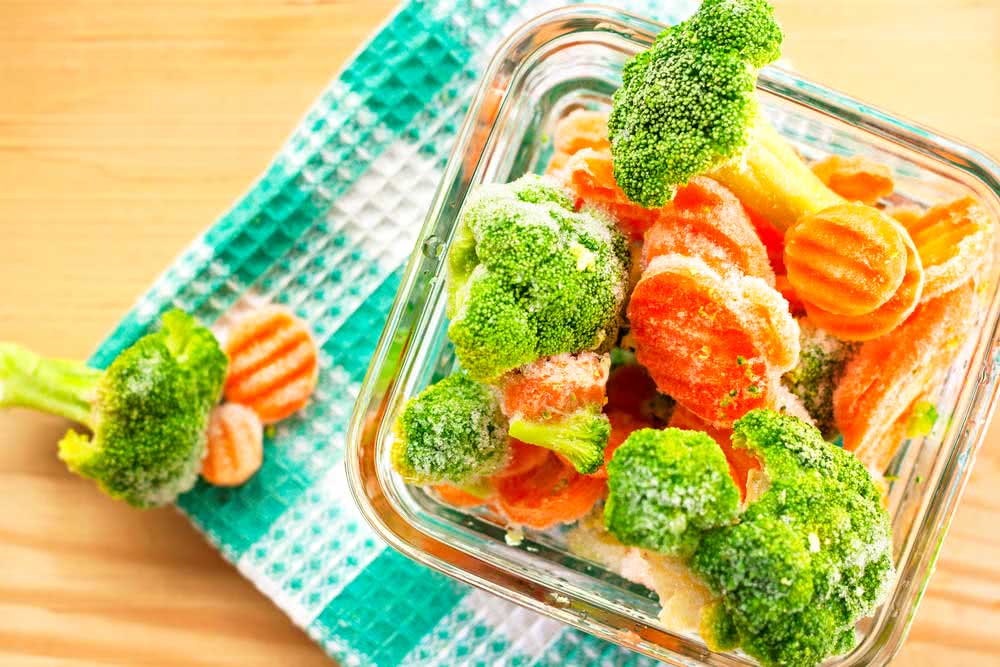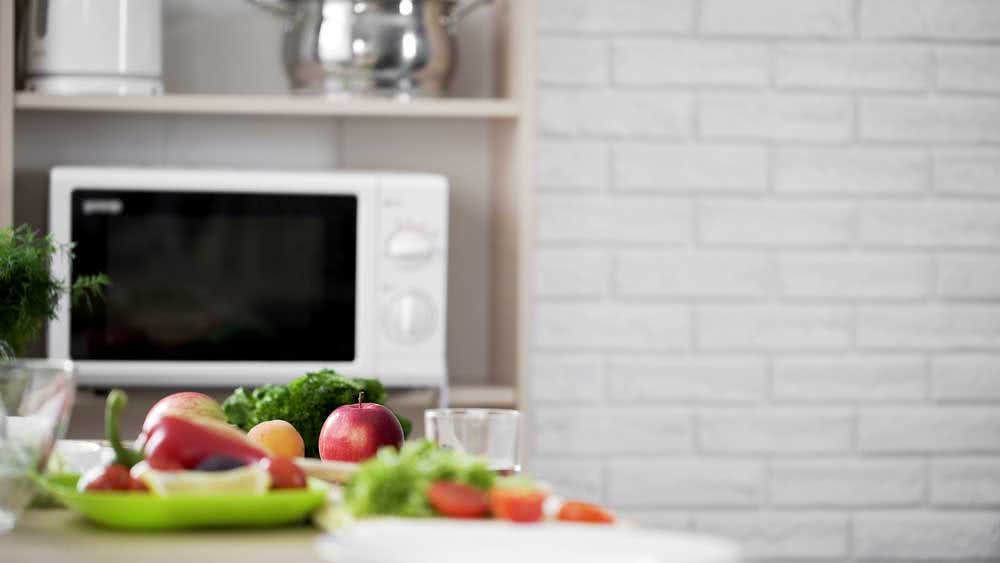At least once in your life you must have been in doubt about what can or cannot go to the microwave.
But luckily, that doubt ends today.
That’s because we brought a complete post with everything that is free to be placed in the microwave and with everything that can’t even pass near the device, including food and materials.
Let’s check the whole list?
What can go in the microwave

Can you use plastic in the microwave? And paper packaging? These and a few more questions we will answer right away, check out:
Foods that can be prepared and heated in the microwave
In general, practically all foods can be taken to the microwave, except for a few types that we will talk about in the next topic. See the list:
Frozen food
Frozen food was made for the microwave. That lasagna or the pizza bought at the supermarket can be heated quietly inside the appliance, as long as you remember to remove the packaging.
But the frozen food in your freezer prepared by you can also be defrosted and reheated in the microwave.
So, use the appliance to heat beans, rice, vegetables and all kinds of food you have there.
Water
Who has never used the microwave to heat and boil water? Well, the device can be used for that too.
But be careful: be very careful when removing hot water and make sure that the container used is suitable for microwave use.
milk
Milk is another super common food to be prepared in the microwave. And there’s no problem with that! It’s cleared.
Bread
Did you know that the bread you bought yesterday can be fresh again if taken in the microwave? Less than a minute is enough to make it look like new.
But be careful just not to overdo the heating time. That’s because bread is a dry food that can catch fire inside the appliance.
Honey
Use the microwave to melt and soften the honey. That’s right! In addition to being able to be heated in the appliance, the honey still regains its consistency and texture with the help of microwaves.
Vegetables and legumes
The vast majority of vegetables and legumes can be heated in the microwave, especially those with thinner skins (Right after that we will tell you which ones cannot be taken to the microwave).
The hardest vegetables should be cut into small pieces to avoid the risk of explosion, as is the case with carrots, for example.
Oilseeds
Peanuts, chestnuts, walnuts, almonds and all kinds of oilseeds are free to heat in the microwave. But for a few minutes.
Meat
Meats of all types can be heated in the microwave. However, it is recommended to slice them before heating so that it receives heat waves evenly.
Meats with a lot of fat, however, can splash and make the most dirt inside the microwave, so be careful.
Also, do not heat (or cook) sausages in the microwave, as you risk seeing them explode.
Materials that can be used in the microwave

See below the list of materials that are released for use in microwaves.
Microwave-friendly plastics
Plastic is not all the same, especially when it comes to microwaves. There are plastic containers and containers suitable for the appliance.
Therefore, always consult the packaging before using and always choose to buy pots suitable for microwave use. This ensures that the plastic will not melt or deform, let alone release toxic substances in the food.
Plastics used in ice cream, margarine and other industrialized containers should not be taken to the microwave. In addition to melting with heat, these packages can contaminate food.
Microwave glasses
As with plastic, glass also has microwave usage restrictions.
As a rule, thick glass jars and refractories can be used without major problems.
Thinner glasses, such as those used for making glasses, for example, should be avoided, since they can crack and even explode with heat.
When in doubt, the tip is the same: see the packaging.
Paper trays
The paper trays that come with lunch boxes and frozen dishes can be taken to the microwave without any risk.
But, just in case, it’s always good to be around. That’s because the paper can catch fire and if it does you will be there to prevent the accident.
Ceramics and porcelain
Plates, cups, glasses and dishes made of ceramics and porcelain can be used in the microwave, with the exception of only those with metallic details.
Baking bags
Plastic bags for microwave cooking are also released. Remember that they must have holes for the steam to escape.
What can’t go in the microwave

Now see everything you should avoid in the microwave.
Foods that cannot be prepared in the microwave
Peppers
Did you know that peppers (whatever the type) when heated in the microwave release a gas that causes irritability and burning in the eyes?
And if left in the device for a long time they can still catch fire.
Better then prepare them on the conventional stove.
eggs
Don’t even think about heating boiled eggs in the microwave. They will explode! What you can do is cut the eggs in half and then heat them.
For those who want to fry or even cook eggs in the microwave, use a proper container for this.
Green leaves
No type of leaf, such as lettuce, almond and arugula, should be taken to the microwave
In addition to wilting, the leaves lose a significant amount of nutrients when exposed to the device.
When you want to consume these heated leaves, do so on the stove.
Sauces
The sauces (tomatoes, pesto, white, shoyo, etc.) are great for causing dirt and mess inside the microwave.
That’s because when they are heated they glisten everywhere. Better to avoid.
Grape
Do not prepare grapes in the microwave. They explode, just like eggs. If you want to heat them, cut them in half.
Vegetables, fruits and vegetables in shell
You may have noticed that all shelled food is a problem in the microwave.
The answer to this is simple: the microwave heats the food from the inside out and the steam generated inside, when there is nowhere to go, ends up generating pressure and boom! It explodes.
Therefore, the tip is always to cut in half, chop into cubes or make holes with a fork so that the steam dissipates.
Baby bottles
Do not heat bottles in the microwave. First because the nozzle can clog and cause an explosion.
Second, because if the plastic used for the bottle is not suitable for microwave use, the milk may end up being contaminated.
Materials that cannot be used in the microwave

Pans and metallic objects
No type of metal, including aluminum and iron, should be used in microwaves. This goes for pans, pots, dishes, cutlery and plates.
These materials give off sparks and there is a high chance of fire if they are placed inside the microwave.
Even a small metallic detail can cause accidents, as is the case with golden fillets in ceramic dishes, for example.
Aluminum paper
Aluminum foil, like metal objects, must also be removed from the microwave.
This goes for food wrapped in aluminum foil, as well as for lunch boxes and pots made with the material.
Styrofoam
Styrofoam packaging also cannot be placed in the microwave. This material releases toxic substances in the food that, when consumed, become harmful to the human organism.
Plain tissue and paper
Fabrics and papers should not be placed in the microwave as they risk catching fire and causing a fire, including bread bags.
Wood and bamboo
Wooden and bamboo utensils can crack, crack and break in half when subjected to microwave heat. So, avoid them too.
Extra care when using the microwave
- The most modern models of microwaves usually present the option « grill ». In this case, it is necessary to pay attention to the function of the device being used. For example, plastic packaging can be used in the microwave function, but not in the grill function. If in doubt, consult the manufacturer or the instruction manual of the device.
- Always stay close to the microwave when heating or preparing food. This prevents accidents.
- For longer preparations, pause the operation half the time to turn the food. Thus cooking takes place equally.
Taking all care you guarantee the useful life of your microwave and still take care of your health.



